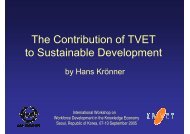Learning for Life, Work and the Future Initial ... - Unesco-Unevoc
Learning for Life, Work and the Future Initial ... - Unesco-Unevoc
Learning for Life, Work and the Future Initial ... - Unesco-Unevoc
You also want an ePaper? Increase the reach of your titles
YUMPU automatically turns print PDFs into web optimized ePapers that Google loves.
Page 52 Participants’ Papers <strong>Learning</strong> <strong>for</strong> <strong>Life</strong>, <strong>Work</strong> <strong>and</strong> <strong>the</strong> <strong>Future</strong><br />
Position Male Female Total<br />
Principal 1 0 1<br />
Deputy Principal 2 0 2<br />
HODs 2 0 2<br />
Senior Lecturer I 0 0 0<br />
Senior Lecturer II 5 0 5<br />
Gaborone Technical College<br />
12. Recommendations<br />
• Establishment of a comprehensive programme in all<br />
VET institutions<br />
• Review of existing policies<br />
• Liaison officers in <strong>the</strong> institutions to ensure that<br />
<strong>the</strong>re is equal participation in decision making,<br />
choice of courses, etc<br />
• Regular sensitisation workshops <strong>for</strong> management at<br />
institutional level<br />
• Intensive campaign to disseminate in<strong>for</strong>mation on<br />
VET<br />
• More open days or career fairs to sensitise young<br />
people towards VET<br />
• Publicity material to be increased <strong>and</strong> widely<br />
distributed.<br />
10 KOPEKA, Charles <strong>and</strong> WATERMAN, Nick (Lesotho):<br />
The Challenge of Mineworker Retrenchment <strong>for</strong> Lesotho –<br />
An Opportunity <strong>for</strong> Community Empowerment <strong>and</strong> Regional Co-operation<br />
1. Introduction<br />
This paper outlines an initiative undertaken by <strong>the</strong><br />
Ministry of Education (MoE) as part of <strong>the</strong> Government<br />
of Lesotho’s poverty alleviation strategy. It seeks<br />
to analyse <strong>the</strong> impact of mineworker retrenchment <strong>and</strong><br />
describes <strong>the</strong> process of planning a programme of<br />
vocational training as a considered response. It is<br />
suggested that a participative approach of stakeholders,<br />
particularly at community level, would contribute to<br />
<strong>the</strong> rejuvenation <strong>and</strong> empowerment of communities.<br />
It is also suggested that strategies <strong>for</strong> addressing retrenched<br />
mineworker unemployment should begin at<br />
<strong>the</strong> source of employment, prior to <strong>the</strong> retrenched<br />
mineworkers’ return, to help <strong>the</strong>m <strong>and</strong> <strong>the</strong>ir families<br />
avoid facing protracted economic <strong>and</strong> social dislocation<br />
at home. The paper concludes that such strategies<br />
provide an opportunity <strong>for</strong> regional co-operation.<br />
2. The Issue<br />
Lesotho has a long history of migrant labour finding<br />
employment in <strong>the</strong> mines of South Africa. The proportion<br />
of Basotho has invariably been around 30% of <strong>the</strong><br />
total mineworker work<strong>for</strong>ce, reaching a numerical high<br />
in 1989 of 127,000 (Mhlanga 1996). In 1994 remittances<br />
from mineworkers accounted <strong>for</strong> 98% of all<br />
those sent by Basotho working abroad <strong>and</strong> 34% of<br />
Lesotho’s GNP (Mhlanga 1996).<br />
Mhlanga (1996) cites important statistics on <strong>the</strong> impact<br />
of mineworker retrenchment. Due to <strong>the</strong> contraction in<br />
gold mining activity <strong>and</strong> <strong>the</strong> localisation of labour in<br />
South Africa, 300,000 mineworkers were retrenched<br />
between 1989 <strong>and</strong> 1999. 75,000 of <strong>the</strong>se were Basotho.<br />
During <strong>the</strong> last decade <strong>the</strong>re has been a 60% drop in<br />
Basotho mineworkers in South Africa. The scale of<br />
retrenchment has been most severe <strong>and</strong> traumatic in<br />
recent years, with a decline in 1998 of over 20% <strong>and</strong> a<br />
fur<strong>the</strong>r 14% decline in1999.<br />
Each mineworker supports, on average, between seven<br />
<strong>and</strong> ten o<strong>the</strong>rs (Monyau, 2000). Consequently, <strong>the</strong><br />
multiplier effect on individuals <strong>and</strong> communities of<br />
retrenched mineworker unemployment has enormous<br />
impact. 95% of retrenched mineworkers express a<br />
desire to settle in <strong>the</strong> villages of <strong>the</strong>ir origin. However,<br />
few if any have any means of sustaining a livelihood<br />
<strong>for</strong> <strong>the</strong>mselves or <strong>the</strong>ir families in indigenous conditions<br />
of subsistence agriculture <strong>and</strong> high unemployment.<br />
Additionally, protracted unemployment of <strong>the</strong><br />
<strong>for</strong>mer primary breadwinner can result in <strong>the</strong> break-up<br />
of families (Monyau, 2000), thus undermining community<br />
cohesion <strong>and</strong> individual <strong>and</strong> collective sustainability.<br />
It has been stated that “<strong>the</strong> proportion of households<br />
defined as poor has increased significantly in Lesotho<br />
since 1990 <strong>and</strong> now includes 68% of <strong>the</strong> population.<br />
Two-thirds of <strong>the</strong> poor live in destitution with barely<br />
enough cash income to satisfy basic food needs.”<br />
(Gay <strong>and</strong> Hall, 2000, p. viii). National unemployment<br />
st<strong>and</strong>s at between 35%<strong>and</strong> 40% (UNDP 1998), <strong>and</strong><br />
toge<strong>the</strong>r with poverty, tends to be most acute in rural<br />
<strong>and</strong> remote areas (Gay <strong>and</strong> Hall 2000).<br />
Over a third of retrenched mineworkers express selfemployment<br />
as providing opportunities <strong>for</strong> paid work<br />
(Mhlanga, 1996). Yet <strong>the</strong>ir capacity to engage in selfemployment<br />
is limited: over half of <strong>the</strong>m have ei<strong>the</strong>r<br />
no <strong>for</strong>mal education or none beyond Grade 4<br />
(Mhlanga, 1994). They tend to lack entrepreneurial<br />
skills <strong>and</strong> few have any previous experience of micro<br />
or small business activity (Mhlanga, 1994).<br />
The return of a comparatively high number of unemployed<br />
people with comparatively low skills levels<br />
exacerbates <strong>the</strong> existing difficulty of absorbing poten-





